|
|
|
Sort Order |
|
|
|
Items / Page
|
|
|
|
|
|
|
| Srl | Item |
| 1 |
ID:
121654
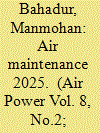

|
|
|
| 2 |
ID:
133979
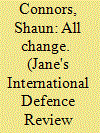

|
|
|
|
|
| Publication |
2014.
|
| Summary/Abstract |
The UK Ministry of Defence's (MoD's) Multi Role Vehicles - Protected (MRV-P) programme is intended to replace around 50% of the current soft-skin Land Rover and Pinzgauer light vehicle fleet with a capability better suited to projected future operational requirements, and a senior defence official has set out from details for the first time.
|
|
|
|
|
|
|
|
|
|
|
|
|
|
|
|
| 3 |
ID:
127933
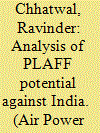

|
|
|
|
|
| Publication |
2013.
|
| Summary/Abstract |
China's growing military build-up and increasing assertiveness against its neighbouring countries has been a reason for concern to many nations. China has territorial and maritime disputes with many of its neighbours . Their major dispute is with Taiwan. Both the countries claim to be the legitimate government of China. China claims to be a part of its territory and has openly stated that it will be ready to use force. If required, to annex Taiwan. China also claims Senkaku islands, also claomed by Japan, as theirs. Another dispute area is Paracel island which is occupied by China but Claimed by Taiwan and Vietnam. China is also involved in a dispute with the Philippines over the Scarborough Shoal. The Spratly islands are another complex bone of contention between China, Taiwan, Malaysia, the Philippines and Vietnam. With India, the border dispute has not yet been resolved.
|
|
|
|
|
|
|
|
|
|
|
|
|
|
|
|
| 4 |
ID:
092622
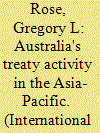

|
|
|
|
|
| Publication |
2009.
|
| Summary/Abstract |
This paper investigates Australian treaty making with neighboring countries in the Asia-Pacific. Patterns of Australian treaty making with South East Asian countries are markedly different to those with South West Pacific countries and the difference is continuing to deepen. Treaties with the former are primarily bilateral and commercially oriented, whereas those with the latter are plurilateral and oriented to natural resources management and development. There is a major gap in Australian subregional treaty activity for natural resources management in South East Asian countries. A coalescence of issues in the law enforcement and security categories is occurring and the new direction in Australian regional treaty making for both subregions is to strengthen capacity to enforce the rule of law in national legal systems. Commercial treaty making remains and is likely to continue to be the strongest area of treaty activity.
|
|
|
|
|
|
|
|
|
|
|
|
|
|
|
|
| 5 |
ID:
131723
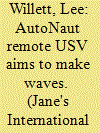

|
|
|
|
|
| Publication |
2014.
|
| Summary/Abstract |
UK based most autonomous vessels (AV) has demonstrated AutoNaut, it new wave-powered unmanned surface vessels (USV), developed as a long - endurance, low signature, autonomous monitoring and surveillance platform.
|
|
|
|
|
|
|
|
|
|
|
|
|
|
|
|
| 6 |
ID:
133482
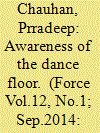

|
|
|
|
|
| Publication |
2014.
|
| Summary/Abstract |
As the world entered the last couple of decades of the 20th century, the sharply differing views and reactions of India and the United States (US) to unfolding global and regional events had brought bilateral relations to almost the nadir of the Nixon years. As James Heitzman and Robert L. Worden, the Washington-based editors of India: A Country Study have recorded (http://www.countrystudies.us/india/134.htm), "In the 1980s the Indian and United States governments had divergent views on a wide range of international issues, including Afghanistan, Cambodia, the Middle East, and Central America. Serious differences also remained over the US policy toward Pakistan and the issue of nuclear proliferation. India was repeatedly incensed in the Eighties when the US provided advanced military technology and other assistance to Pakistan despite the US' concerns about Pakistan's covert nuclear programme. For its part, Washington continued to urge New Delhi to sign the Treaty on the Non-Proliferation of Nuclear Weapons and, after the successful test launch of the Indian Agni intermediate-range ballistic missile in May 1989, called on New Delhi to refrain from developing a ballistic missile capability by adhering to the restrictions of the Missile Technology Control Regime". This unhappy prelude makes the vibrancy of the India-US bilateral defence relationship in general (and the maritime relationship in particular) over the very next decade all the more striking.
|
|
|
|
|
|
|
|
|
|
|
|
|
|
|
|
| 7 |
ID:
129864
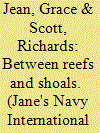

|
|
|
|
|
| Publication |
2014.
|
| Summary/Abstract |
Budget cuts and programme uncertainty are blurring the planning horizons for surface warship constructors in the United States.
|
|
|
|
|
|
|
|
|
|
|
|
|
|
|
|
| 8 |
ID:
133349
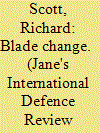

|
|
|
|
|
| Publication |
2014.
|
| Summary/Abstract |
By late 2020 the UK RN will have replaced its legacy helicopter fleet with new or upgraded rotocraft, Richard Scott charts the progress of the wildcat and Merlin programmes.
|
|
|
|
|
|
|
|
|
|
|
|
|
|
|
|
| 9 |
ID:
131327


|
|
|
|
|
| Publication |
2014.
|
| Summary/Abstract |
This study presents a framework and models for the analysis of government budget allocation into defense and civilian expenditures in situations of uncertainty about the incidence of war. The models display the intricate relationships between security levels, subjective probabilities of the occurrence of war, and potential war damages. We show that poor countries tend to perceive greater probabilities of war than their richer rivals, and that the psychological burden of insecurity is larger when the country's wealth is larger and when its preference for security is higher. We apply our models to the Israeli-Syrian arms race and show that the higher rate of growth of Israel's gross domestic product relative to that of Syria is expected to lead to an increase in Syria's perception of the likelihood of war and to a decrease in Israel's perception of such a likelihood. We also show that if Syria's regime becomes ideologically more extreme, the monetary cost of maintaining Israel's security at the level that it enjoyed prior to the change will be very high, whereas the monetary cost of maintaining Israel's welfare will be moderate.
|
|
|
|
|
|
|
|
|
|
|
|
|
|
|
|
| 10 |
ID:
052284
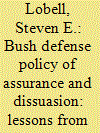

|
|
|
|
|
| Publication |
Apr-Jun 2004.
|
|
|
|
|
|
|
|
|
|
|
|
|
|
|
|
| 11 |
ID:
132932
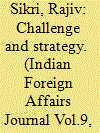

|
|
|
|
|
| Publication |
2014.
|
| Summary/Abstract |
For some time now, there has been a buzz about India's growing role in the world and a widespread feeling that India must play a much larger global role. Today, this feeling has become far more acute.
It is important, then, that there should be greater, and more widespread, awareness of foreign policy challenges faced by India, as well as a deeper understanding of the stakes and options for India's foreign policy. The public needs to be more knowledgeable about foreign affairs, which cannot be the concern only of those who exercise power in New Delhi. It is something in which every citizen should be involved. It is also essential that there should be a vibrant and constructive debate, especially involving the young, on where we are headed and why, because unless there is public support our foreign policy will not be successful. Some recent incidents pertaining to our relations with Sri Lanka and Bangladesh where the Chief Ministers of Tamil Nadu and West Bengal respectively forced the hand of the Central Government illustrate this point. I am glad that the BJP manifesto talks about having a "Team India" that brings together the Prime Minister and the Chief Ministers of States.
My conversation with you today is a small effort to create this awareness, perhaps stimulate your imagination and set you thinking.
|
|
|
|
|
|
|
|
|
|
|
|
|
|
|
|
| 12 |
ID:
133045
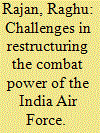

|
|
|
|
|
| Publication |
2014.
|
| Summary/Abstract |
The IAF's capability covers the IOR counties on the maritime side and its principal adversaries Pakistan and China on the landward side
|
|
|
|
|
|
|
|
|
|
|
|
|
|
|
|
| 13 |
ID:
132996
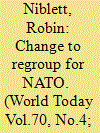

|
|
|
|
|
| Publication |
2014.
|
| Summary/Abstract |
In a world of flashpoints and European defence cuts the alliance needs strengthening, when the British government offered to host the NATO summit in Wales on September,4-5, few foresav that this would be a defining moment in the history of the Atlantic Alliance.
|
|
|
|
|
|
|
|
|
|
|
|
|
|
|
|
| 14 |
ID:
131182
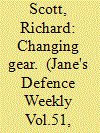

|
|
|
|
|
| Publication |
2014.
|
| Summary/Abstract |
Although a main gate decision on the UK's successor deterrent submarine programme is not due until 2016, investment in engineering, facilities and long led material is already ramping up. Richard Scott assesses the status of the programme.
|
|
|
|
|
|
|
|
|
|
|
|
|
|
|
|
| 15 |
ID:
133576
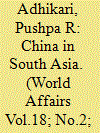

|
|
|
|
|
| Publication |
2014.
|
| Summary/Abstract |
India has reason to fear Chinese encirclement, while the growing assertiveness and self-confi dence of the PLA is a cause for concern. Head-on confrontation between the two could largely destroy these ancient civilisations, while the prospect for peace could bring prosperity to not only South Asia, but the greater Asian region as a whole. Pushpa R Adhikari asserts that building confi dence and cooperation between all states in the region is vital for its progress and stability.
|
|
|
|
|
|
|
|
|
|
|
|
|
|
|
|
| 16 |
ID:
137461
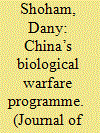

|
|
|
|
|
| Summary/Abstract |
This study attempts to profile China’s biological warfare programme (BWP), with special reference to biological weapons (BW) capabilities that exist in facilities affiliated with the defence establishment and the military. For that purpose, a wide variety of facilities affiliated with the defence establishment and with the military are reviewed and profiled. The outcome of that analysis points at 12 facilities affiliated with the defence establishment, plus 30 facilities affiliated with the PLA, that are involved in research, development, production, testing or storage of BW. This huge alignment might be regarded as superfluous, ostensibly; yet, considering the various factors discussed in the present study, the overall derived picture of the Chinese BW-related alignment is not at all surprising. The chances that an outstanding state like China would ignore new avenues of BW designing and deployment are a priori slim, if any. China, in all likelihood, is and will persist as a paramount BW possessor.
|
|
|
|
|
|
|
|
|
|
|
|
|
|
|
|
| 17 |
ID:
133671
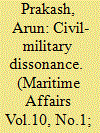

|
|
|
|
|
| Publication |
2014.
|
| Summary/Abstract |
The civil-military equation has been assigned great significance in the national security matrix, and experts consider that nations that fail to evolve a stable paradigm of civil-military relations squander their resources and run grave security risks. In India, this issue has failed to receive the importance it deserves because of the general indifference of the politicians to national security affairs on one hand, and the vested interest of the bureaucracy in maintaining the status quo on the other. It is believed that civil-military relations constitute a zero-sum game in which "civilian control" is retained by reducing the power of the military vis-à-vis the civilians. An irrational but subliminal fear of the military has led the Indian politicians to skew the civil-military equation in favour of the bureaucracy and, in a paradigm unique to India, to place the military under their control. Pointing to the military's sense of grievance and the vitiated atmosphere that prevails in the Ministry of Defence, the author reflects on the price being paid by the nation for endemic "civil-military dissonance" in terms of major national-security shortcomings, as well as the damage being inflicted on the institution of our armed forces.
|
|
|
|
|
|
|
|
|
|
|
|
|
|
|
|
| 18 |
ID:
134099
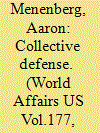

|
|
|
|
|
| Publication |
2014.
|
| Summary/Abstract |
Since the end of World War II, Japan has relied on the United States for its security, an arrangement enshrined in the US-written Japanese Constitution of 1947 and augmented by subsequent agreements between the two allies. Article IX of the Constitution prohibits Japan from taking part in any conflict or building a traditional military. (When President George H.?W. Bush organized the "coalition of the willing" against Iraq in 1991, Japan was able only to offer financial assistance because of this stipulation.) But with the rise of China and its assertion of sovereignty in regions Japan claims as its own, Tokyo has begun to expand its military capability. Some government officials wonder how these moves will affect relations with the United States, Japan's protector for the last half-century.
|
|
|
|
|
|
|
|
|
|
|
|
|
|
|
|
| 19 |
ID:
129184
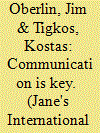

|
|
|
|
|
| Publication |
2014.
|
| Summary/Abstract |
With software defined radios set to dominate the tactical domain Kostas Tigkos and Jim Oberlin investigate the current offering and look at the next generation systems expected to drive the market towards the future cognitive CNR.
|
|
|
|
|
|
|
|
|
|
|
|
|
|
|
|
| 20 |
ID:
131466


|
|
|
|
|
| Publication |
2014.
|
| Summary/Abstract |
This article examines the complex legacy of David Petraeus who was a key figure in the emergence of the US military shift towards counterinsurgency doctrine in the years after 2006. Although Petraeus has been perceived by critics as a publicity seeker, he can be credited with laying the foundations for a more serious commitment to COIN involving in particular in integrating conventional and Special Forces in arenas like village stability operations. The article looks a Petraeus's role in both Iraq and Afghanistan: it concludes that, in the case of Afghanistan, it is too early to assess whether counterinsurgency has had a decisive impact of the outcome of the war against the Taliban.
|
|
|
|
|
|
|
|
|
|
|
|
|
|
|
|
|
|
|
|
|